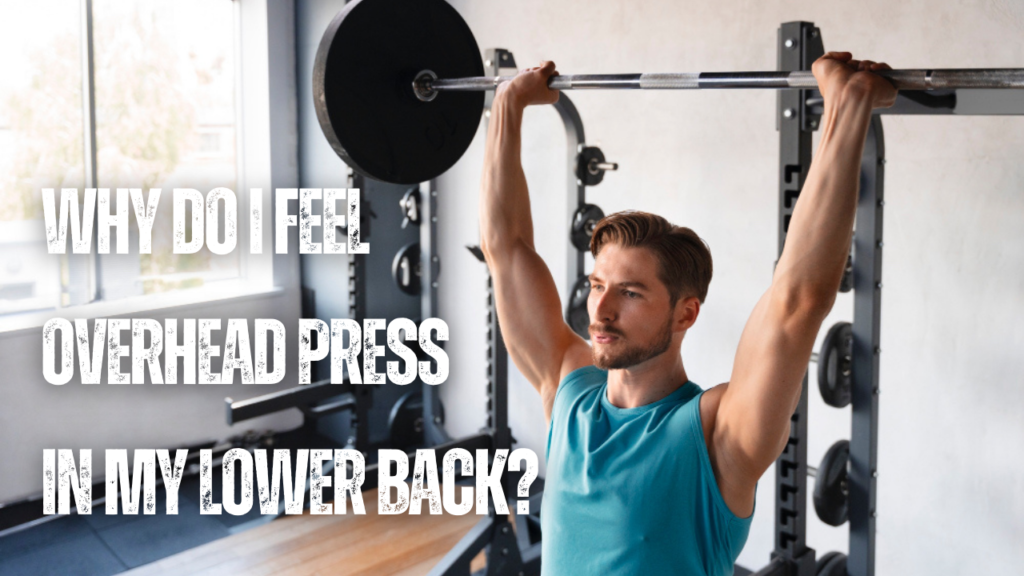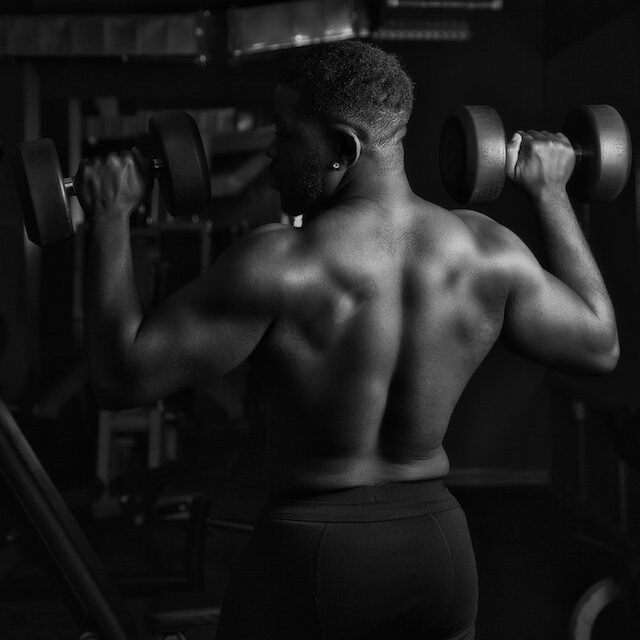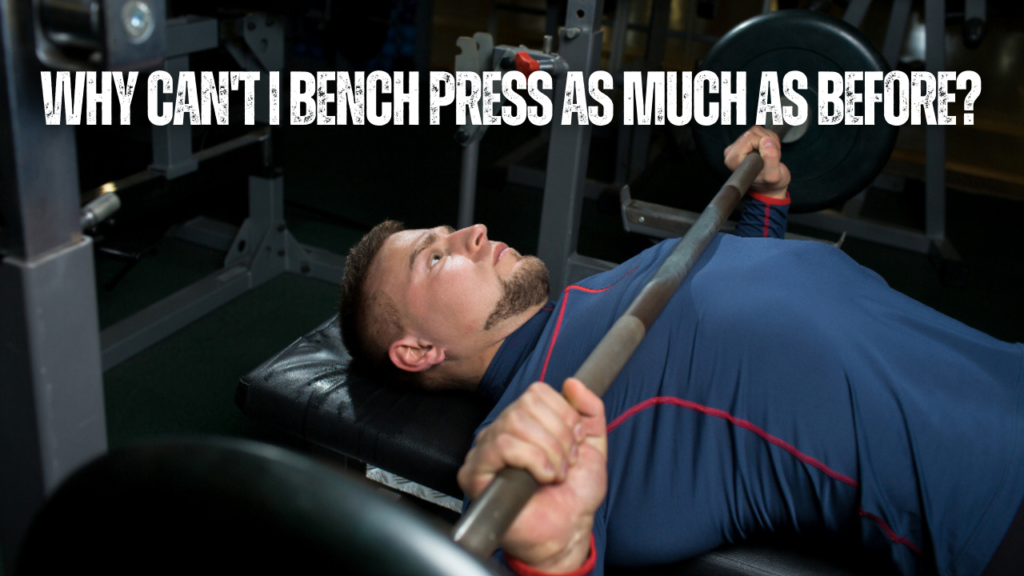
Why Do I Feel Overhead Press In My Lower Back? 10 Tips To Fix Issue
Do you ever feel your lower back burning as you go through a shoulder press exercise? It’s a common frustration for those looking to increase their strength.
Don’t worry though there are things that can be done to both help reduce the problem and get better results from this important exercise.
In this blog post, we’ll take a look at why pressing movements like shoulder presses target our lower back muscles so much and how we can reduce the issue to maximize all of the benefits. Read on to find out why your lower back might hurt when doing shoulder presses…
Why Do I Feel Overhead Press In My Lower Back?
The primary reason why you may feel your lower back muscles when doing shoulder presses is due to weak or tight muscles in the area, previous injuries or a combination of both. Another common problem could be arching of the back and puffing out of the chest as well as lifting too heavy for your current fitness level. This can lead to increased lumbar curvature which will put increased pressure on the lower section of the back. Reduced shoulder range of motion (ROM) can also be a factor in why you may feel lower back muscles when doing overhead presses. One way to reduce the risk of feeling your lower back during shoulder pressing exercises is to modify your form. Make sure you keep your centre of gravity between the barbell and body, use an appropriate bar path and make sure you are bracing your entire torso and not just your arms. It is also important to consider why you are doing the exercise in the first place and how it relates to your overall goals. For example, if you’re looking for more shoulder strength, why not take a seat instead? Sitting down will help keep your core engaged and reduce any stress on the lower back. Additionally, why not try different variations of the shoulder press such as using dumbbells instead? Muscle imbalances and fatigue can also be contributing factors to why your lower back might hurt when doing shoulder presses. Make sure you take ample rest between sets and focus on building up strength gradually in order to reduce any risk of injury.
Let’s now look more in-depth at the reasons above and how you can adjust your form to reduce lower back pain when doing shoulder presses.
1. Weak or tight muscles and previous injuries
It’s important to consider why you are feeling your lower back when doing shoulder presses. If it’s due to weak or tight muscles, or a previous injury, then it is best to address these issues first before attempting the exercise again. If you have suffered from any kind of lower back pain in the past (I have and it’s very frustrating) or have weaker Iliopsoas, Quadratus Lumborum, Gluteals or Multifidus muscles, then it would be well worth strengthening these areas before attempting any overhead press exercises.
Having tight deltoids can also be a potential issue when it comes to why you might feel your lower back because tight muscles will encourage the rounding of your shoulders. This will then lead to increased pressure in the lower back due to the added curvature.
Working on mobility and flexibility exercises such as foam rolling can help loosen up tight muscles while also strengthening any weak muscles. Doing exercises such as planks, bird dogs, back extensions and yoga can also help build strength in the lower back. Doing this alone can make a massive improvement in your lower back strength.
2. Arching back and puffing chest
When doing shoulder presses, it’s important to maintain a neutral spine position throughout the exercise. This means avoiding arching the back or puffing the chest out. Doing so will put unnecessary strain on the lower back and can lead to increased pain or injury. This is also a sign that you are trying to press too much weight as you are leaning back in order to get the extra leverage.
While it is natural to arch your back and tilt your head upwards when the barbell approaches your face, fight the urge as much as possible. Minimizing movement in this position will ensure a more effective lift with fewer risks of injury. Keep your chest up instead of puffing it out and make sure you do not swing the barbell up as this will increase the risk of injury.
In order to maintain a neutral spine, make sure you are engaging your core muscles and actively pressing your shoulder blades down and together. This will help keep your posture in check, enabling you to lift with correct form while avoiding any additional pressure on the lower back.
3. Lifting too heavy
When attempting any new exercise, it is best to start with a light weight and work your way up from there. Lifting too heavy can put a lot of strain on the body and increase the risk of injury. It’s important to understand your own limits and not be tempted to lift too much weight too quickly.
I mention this every time but, we have all seen those people at the gym trying to lift way too much weight, which is not only dangerous for them, but also for those around them in case the bar slips or something happens.
In order to avoid putting too much pressure on the lower back, you should be focusing on the mechanics of the exercise instead of just adding more weight. A good way to do this is by doing sets of 5–10 reps with a moderate weight. This will help you build up strength in your shoulders and reduce the risk of injury.
4. Reduced shoulder ROM
Having a reduced range of motion (ROM) in the shoulder can be an important factor as to why you may feel your lower back when doing overhead presses. The shoulder is a very delicate joint which requires a lot of stability and mobility in order to perform overhead presses effectively.
If your shoulder ROM is reduced, then you will likely experience pain or discomfort in the lower back due to the strain being put on it as you press the barbell up. It’s important to focus on strengthening and stretching exercises which target the shoulders such as shoulder shrugs, shoulder rolls and wrist circles. Doing these regularly will help to increase shoulder mobility and reduce pressure on the lower back.
The barbell might be the other reason why you struggle with shoulder ROM due to the way it’s held. If this is the case then why not try dumbbells instead? Holding two dumbbells will allow you to maintain a more neutral grip with the wrists in line with the forearms. This should help improve shoulder ROM and reduce any strain being placed on the lower back.
Related: Why Do I Feel Shoulder Press In My Forearms?
5. Take a seat instead?
In order to reduce strain on the lower back, it may be worth trying an overhead press from a seated position. This can help you maintain a neutral spine position, as the back will be supported by the chair and won’t be forced to bear any additional weight.
In addition, it can help you focus on targeting the shoulders rather than relying on other less-used muscles in order to lift the weight. Seated overhead presses can also help you build up strength gradually as you are working with less weight.
The seated shoulder press with dumbbells can be a great alternative to the traditional standing overhead press. It allows you to target the same muscles while reducing strain on the lower back and helping improve shoulder ROM. Just be careful as heavier dumbbells can be difficult to control in the seated position, so it’s best to start light and work your way up from there.
6. Form
The standing shoulder press is a compound exercise which requires a lot of moving parts to complete the lift correctly. The key to avoiding any lower back pain is to ensure that you have good form and body alignment. We have already mentioned quite a few reasons why your lower back may hurt regarding your form being questionable. There are a few more pointers to consider during the movement…
Centre of gravity bar and body
When doing the movement make sure that the centre of gravity is balanced between the bar and your body, in order to keep a stable base for the lift. If either of these isn’t correct it can lead to an incorrect bar path which will make the exercise more difficult and also increase the chances of lumbar curvature. Remember the bar should only be travelling up and down, not at any other angle/direction.
Your stance
Your feet should be shoulder-width apart with your toes pointing forward. Keep your chest up and your back slightly arched to maintain a neutral spine position. Some find a staggered stance to be more beneficial and comfortable, this involves having one foot slightly further forward than the other. It’s worth trying out both stances and seeing which works best for you.
Not bracing the entire torso or glutes
When pressing, ensure that you are taking a deep breath and bracing your entire torso and glutes to create an internal pressure which helps protect the spine from injury. Your core should also be engaged by squeezing it tight as you press the bar up. This can help to further protect your lower back from unnecessary strain.

7. Muscle imbalances
Although other contributing factors can cause lower back pain during overhead shoulder presses, muscle imbalances may be the underlying cause. It’s important to always warm up properly before doing any exercise and pay particular attention to the muscles around your shoulders. This includes stretching out your lats and upper back, which helps to stabilise the shoulder joint and support the shoulder press movement.
If any number of muscles are weaker for any reason, it will mean the more competent muscles will need to work harder in order to lift the weight and this can lead to lower back pain. It is important to address any muscle imbalances by targeting weakened muscles with specific exercises and having a well-rounded fitness program.
I also recommend seeing a physiotherapist for assistance in strengthening and stretching out these muscles in order to improve balance and reduce lower back pain from overhead presses.
8. Variations to reduce lower back pain
There are quite a few shoulder press variations which can help target the same muscles and reduce strain on your lower back. The landmine shoulder press is a great variation as it allows you to keep your core and lower back braced while still targeting the same muscles.
Another good variation is the Arnold press with dumbbells, which places a greater emphasis on shoulder mobility and stability. It also helps to reduce the chance of failing at lockout as well as reducing strain on the lower back. The military press can also be done with a chair or in a seated position, which helps to stabilise the core and prevents any excess strain on the lower back.
Furthermore, you can try out the single arm press to help even out any muscle imbalances, as well as keep the lower back engaged throughout the movement.
Related: Wrist Pain From Lateral Raises?
9. Fatigue
Fatigue is another big contributing factor to why people experience lower back pain while overhead pressing. This is because it can increase the risk of form breakdown, which in turn will increase the chance of injury.
You should know in yourself when you are starting to become fatigued and should stop before you reach that point, otherwise the risk of injury is increased. Make sure to take regular rest periods during your workout, especially when doing heavy lifts like shoulder presses.
I’d like to think most people would be doing their overhead press early on in their workouts to get the most out of the exercise. However, if this is not the case, why not try switching up your order of exercises and doing them first when you are less tired? This can help to ensure you stay in good form and reduce the chance of lower back pain.
10. Your posture
If you spend a lot of time sitting at a desk, it is likely that your posture needs to be addressed. Poor posture can lead to lower back pain and other alignment issues, which can then lead to further injury.
It’s important to avoid slouching and hunching over and instead focus on engaging your core and maintaining a good posture throughout the time spent sitting at a desk (easier said than done I know). It’s worth investing in a good-quality chair or desk set-up as well as incorporating regular stretches into your daily routine.
Having a poor posture will translate over to your shoulder press as well, so it is important to address this if you’re experiencing lower back pain. If you’re not sure what good posture looks like, why not visit a physiotherapist who can assess and advise you on how to improve your posture?
FAQs
Does overhead press cause back pain?
It is possible for overhead presses to cause back pain, however, it depends on the individual and how their body responds to exercise. If the lift is performed incorrectly or with too much weight, then it can put a strain on the spine which can lead to discomfort or injury. Proper form and practice should be used when performing any heavy exercises, including overhead presses. If you are experiencing back pain after overhead pressing, then it is best to stop and seek medical advice from a healthcare professional. It is also important to take any necessary precautions when performing exercises to reduce the risk of injury or strain on your body.
Where should you feel overhead press?
There are multiple places you should feel the overhead press exercise. You should primarily be feeling it in your shoulders, with some work also being done in your traps and triceps as well. It’s important to keep proper form when performing the overhead press – maintain a tight core, keep your back straight and avoid arching or rounding it, and press the weight straight up and over your head. You should also feel like you are engaging your glutes and driving through your heels to help lift the weight. Lastly, make sure to finish the movement by bringing the bar back down to your collarbone with control and stability before repeating.
How far down should you go on an overhead press?
The correct answer is to lower the bar just below your chin level. This will ensure that you are getting the full range of motion in the exercise and engaging all of the muscles involved. Make sure to keep your elbows close to your body as you press up, as this will help you maintain proper form and get the most out of each rep. If moving the bar any lower causes pain or discomfort in your shoulder, it is best to stop and rest. It may be beneficial to consult with a personal trainer or physical therapist if you experience chronic shoulder pain when performing the overhead press.
Should you fully extend on overhead press?
The answer to this question really depends on your goals and level of experience. If you are looking to increase hypertrophy (muscle size), it is important to extend fully at the top of each rep. This helps ensure that all muscle fibres in the working muscles are activated and stressed, which leads to greater gains in size. On the other hand, if the goal is to increase strength, then a shorter range of motion can be used where you don’t fully extend. This allows the lifter to lift heavier weights while still focusing on proper form and technique. It is important, however, that your form remains consistent throughout each rep regardless of whether you are doing full extension or not.
Does overhead press have to touch chest?
No, it does not have to touch the chest. This is a common myth that exists in weightlifting circles; however, there are many variations of the overhead press that can be used without ever touching the chest or even involving the pectoral muscles at all. These variations include narrower hand placements, wider hand placements, one-handed presses, or pauses at various points in the lift. Ultimately, it is up to the individual lifter to decide which variation works best for their own specific needs and goals. Experimentation with different variations can help you find the most effective technique for your particular situation.
Final thoughts…
Lower back pain is a common issue amongst those who do shoulder presses, but with the right adjustments and form checks, it can be avoided. Ensure you’re engaging your core throughout the movement as well as keeping an eye on fatigue levels and posture.
It is also important to address any muscle imbalances which may be contributing to why you feel shoulder press in your lower back. Make sure to target weakened muscles with specific exercises and have a well-rounded fitness program. Lastly, why not try out some variations of the shoulder press to reduce strain on the lower back? Good luck!
Does your lower back hurt when doing overhead press and have these tips helped? Let me know in the comments section below.


